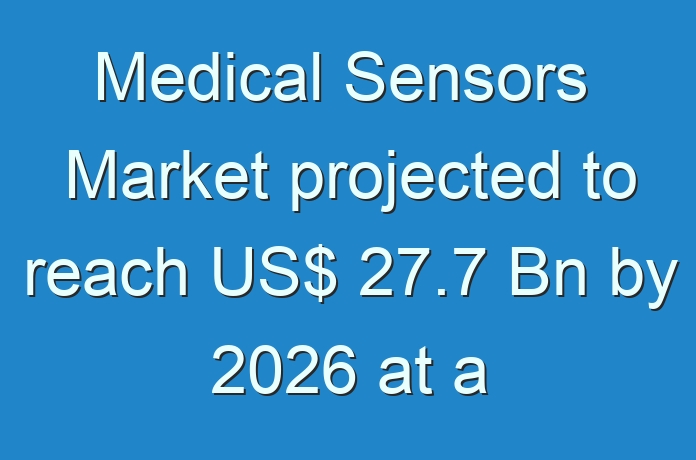
Transparency Market Research (TMR) has published a new report titled, “Medical Sensors Market – Global Industry Analysis, Size, Share, Growth, Trends, and Forecast, 2018–2026”. According to the report, the global medical sensors market is projected to reach US$ 27.7 Bn by 2026 at a CAGR of 9.9% from 2018 to 2026. Factors such as increase in government initiatives for the adoption of mHealth products and rise in adoption of Internet of Things (IoT) and other medical advancements are propelling the global market. Moreover, increase in public and private investments in mHealth products and rise in adoption of smartphones and other electronics with sensor technology boost the growth of the global medical sensors market. The Americas is projected to dominate the global medical sensors market owing to availability of advanced health care infrastructure and high consumption of medical devices. Asia Pacific and Europe, Middle East, and Africa (EMEA) are potential markets. The medical sensors market in Asia Pacific is expected to expand at a CAGR of 11.4% during the forecast period. Increase in focus on development of medical sensors in the past few years, improvement in health care infrastructure, and early detection of diseases fuel the growth of the medical sensors market in Asia Pacific and EMEA.
Request Brochure for Report – https://www.transparencymarketresearch.com/sample/sample.php?flag=B&rep_id=407
Rise in Government Initiatives for Adoption of mHealth Products and Increase in Public and Private Investments in Medical Sensor Companies to Drive Market
Increase in government initiatives for adoption of mHealth products drives the global market. The U.K. Government Department of Health started the NHS digitization initiative in 2016 and allocated over US$ 6.0 Bn for it. More than US$ 2.6 Bn was allotted to transfer paper records to a centralized electronic record system, implementation of wireless technologies, and addressing cyber security concerns in NHS IT ecosystem. New innovations in the health care industry in terms of medicine are fast and productive. IoT has emerged as the next wave in the industry. Google and Novartis launched their combined plan in 2014 to create a connected lens with the ability to monitor blood glucose levels by analyzing an individual’s tears.
Implantable Sensors to be Highly Lucrative Segment
Implantable sensors is an emerging segment of medical sensors. The segment is projected to account for 28.5% share of the market by 2026. It is anticipated to expand at a CAGR of 12.0% during the forecast period from 2018 to 2026. Advancements in sensor technology and rise in demand for continuous monitoring systems such as continuous glucose monitoring (CGM) are anticipated to boost the growth of the segment during the forecast period.
Request for Analysis of COVID19 Impact on Medical Sensors Market – https://www.transparencymarketresearch.com/sample/sample.php?flag=covid19&rep_id=407
Home Care Settings to be Promising Segment
In terms of end-user, the global medical sensors market has been segmented into hospitals, clinics, home care settings, and others. The hospitals segment held the major share of the global market in 2017. The segment is projected to expand at a CAGR of 9.2% from 2018 to 2026. The home care settings segment is anticipated to expand at a CAGR of 12.7% during the forecast period. The segment is expected to gain market share by 2026. Rise in use of wearable health tracker for the measurement of blood pressure, heart rate, and metabolites such as glucose and lactate are the factors likely to boost the use of medical sensors in the home care settings segment.
Americas Projected to Dominate Global Market
The global medical sensors market has been divided into three major regions: the Americas, Europe, Middle East and Africa, Asia Pacific. The Americas dominated the global market in 2017. The market in the region was valued at US$ 6.27 Bn in 2017. This is attributed to the availability of advanced health care infrastructure and high consumption of medical devices in the region. The medical sensors market in the Americas is projected to expand at a CAGR of 9.0% during the forecast period. Biosensors and wearable sensors are the two most promising segments in the region. The medical sensors market in Asia Pacific is expected to expand at a CAGR of 11.4% during the forecast period. The region is likely to gain market share due to rise in prevalence of chronic disorders and surge in awareness about medical sensors among the people. Rise in disposable income of people also contributes to the growth of the market in Asia Pacific and EMEA. Increase in focus on development of medical sensors in the past few years, improvement in health care infrastructure, and early detection of diseases fuel the growth of the medical sensors market in APAC and EMEA.
BUy Medical Sensors Market Report –
https://www.transparencymarketresearch.com/checkout.php?rep_id=407<ype=S
Honeywell International, Inc. and Medtronic to Lead Global Market
The global medical sensors market is semi-consolidated in terms of number of players. Key players in the global market include Cardiomo, Honeywell International, Inc., TE Connectivity, Dexcom, Inc., Medtronic, Danaher Corporation, First Sensor AG, Sensirion AG, Smiths Group plc, and GluSense Ltd. Honeywell International, Inc. and Medtronic were the market leaders in 2017 and are expected to dominate the market during the forecast period. Developing new technologies and products as well as merger and acquisition are the key strategies followed by the key players.
Contact
Transparency Market Research,
90 State Street, Suite 700,
Albany, NY 12207
Tel: +1-518-618-1030
USA – Canada Toll Free: 866-552-3453





